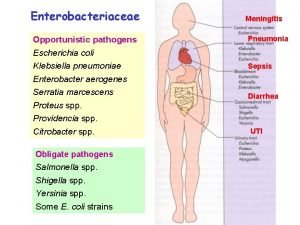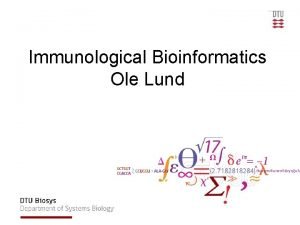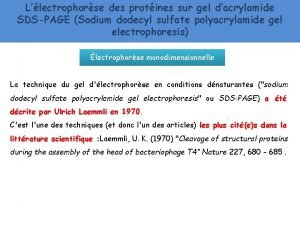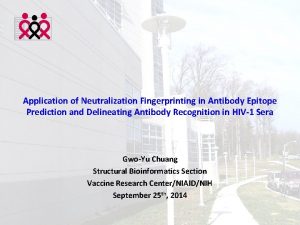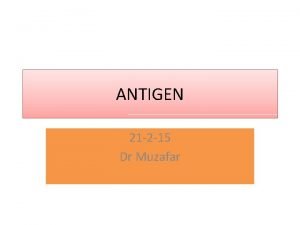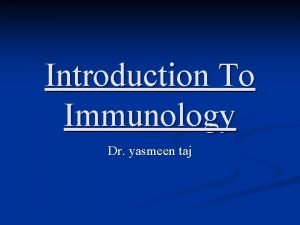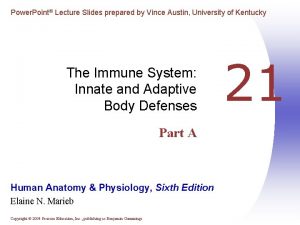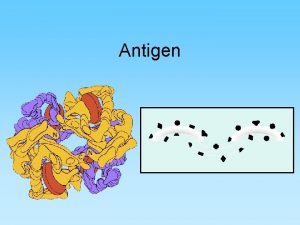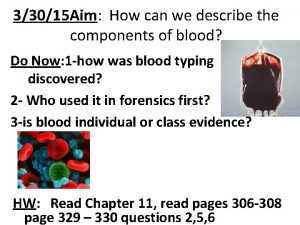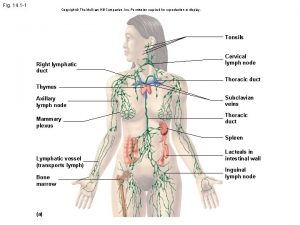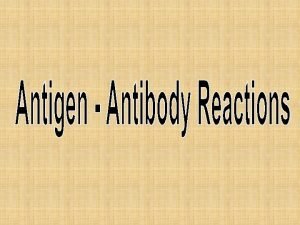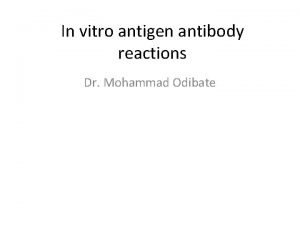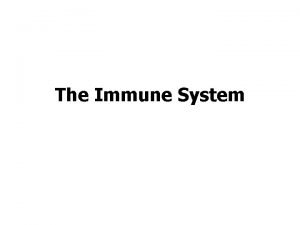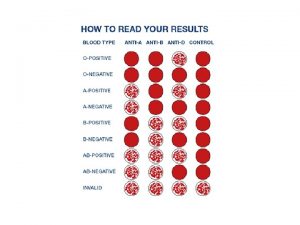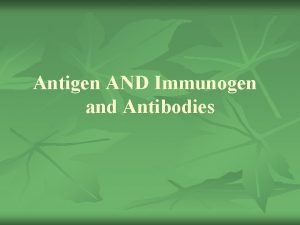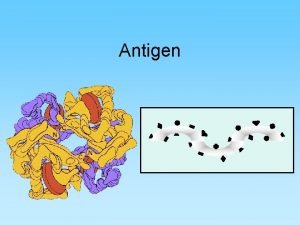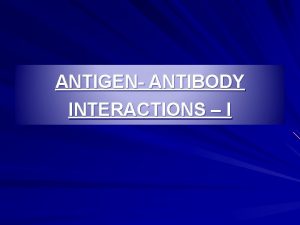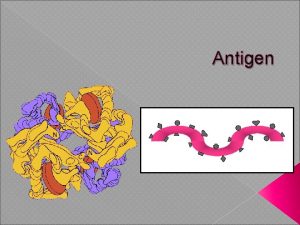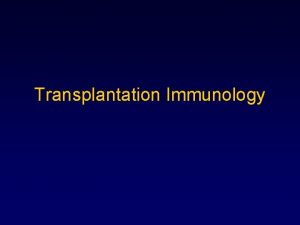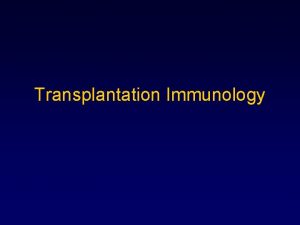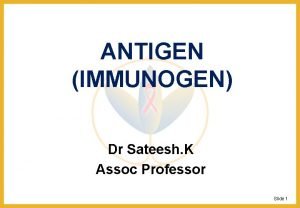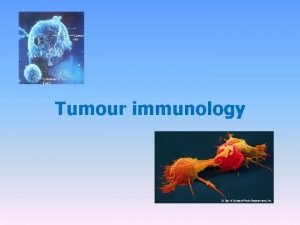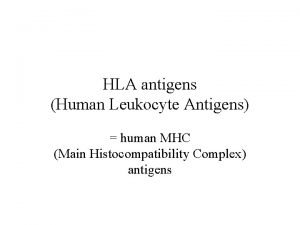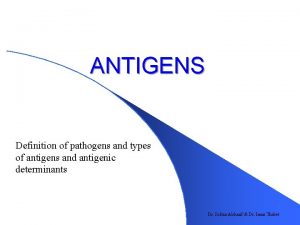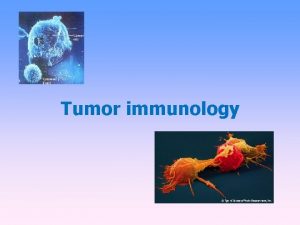Antigens Definitions Immunogen Antigen Ag Hapten Epitope or



















- Slides: 19


Antigens

Definitions • • • Immunogen Antigen (Ag) Hapten Epitope or Antigenic Determinant Antibody (Ab)

Factors Influencing Immunogenicity Contribution of the Immunogen • Foreignness • Size • Chemical Composition – Primary Structure – Secondary Structure – Tertiary Structure – Quarternary Structure Sequence determinants Conformational determinants

Factors Influencing Immunogenicity Contribution of the Immunogen • • • Foreigness Size Chemical Composition Physical Form Degradability – Ag processing by Ag Presenting Cells (APC)

Factors Influencing Immunogenicity Contribution of the Biological System • Genetics – Species – Individual • Responders vs Non-responders • Age

Factors Influencing Immunogenicity Method of Administration • Dose • Route – Subcutaneous > Intravenous > Intragastric • Adjuvant – Substances that enhance an immune response to an Ag

Chemical Nature of Immunogens • • Proteins Polysaccharides Nucleic Acids Lipids – Some glycolipids and phosopholipids can be immunogenic for T cells and illicit a cell mediated immune response

Types of Antigens T-independent • Polysaccharides • Properties – Polymeric structure – Polyclonal B cell activation • Yes -Type 1 (TI-1) • No - Type 2 (TI-2) – Resistance to degradation • Examples – Pneumococcal polysaccharide, lipopolysaccharide – Flagella

Types of Antigens T-dependent • Proteins • Structure • Examples – Microbial proteins – Non-self or Altered-self proteins

Antigenic Determinants Recognized by B cells and Ab • Composition – Proteins, polysaccharides, nucleic acids – Sequence (linear) determinants – Conformational determinants • Size – 4 -8 residues

Antigenic Determinants Recognized by B cells and Ab • Composition • Size • Number – Limited (immunodominant epitopes) – Located on the external surfaces of the Ag Fe

Antigenic Determinants Recognized by T cells • Composition – Proteins (some lipids) – Sequence determinants • Processed • MHC presentation (lipid presentation by MHC-like CD 1) • Size – 8 -15 residues • Number – Limited to those that can bind to MHC

Determinants Recognized by the Innate Immune System • PAMPs – Pathogen Associated Molecular Patterns • PRRs – Pattern Recognition Receptors

PAMP PRR Microbial cell wall Complement components Biological Consequence of Interaction Opsonization; Complement activation Mannosecontaining carbohydrates Mannose-binding protein Opsonization; Complement activation Polyanions Scavenger receptors Phagocytosis Lipoproteins of Gram + bacteria Yeast cell wall components TLR-2 (Toll-like receptor 2) Macrophage activation; Secretion of inflammatory cytokines

PAMP Double stranded RNA PRR TLR-3 LPS TLR-4 (lipopolysaccharide of Gram – bacteria Flagellin (bacterial TLR-5 flagella) Biological Consequence of Interaction Production of interferon (antiviral) Macrophage activation; Secretion of inflammatory cytokines

PAMP PRR Biological Consequence of Interaction U-rich single TLR-7 stranded viral RNA Production of interferon (antiviral) Cp. G containing DNA Macrophage activation; Secretion of inflammatory cytokines TLR-9

Any Questions? ?

Thank YOU
 E coli treatment
E coli treatment Ali salanti
Ali salanti Epitope
Epitope Epitope
Epitope Hapten definition
Hapten definition Hapten definition
Hapten definition Hapten definition
Hapten definition Superantigen
Superantigen Spleen structure
Spleen structure Autospecificity
Autospecificity Thymus independent antigens
Thymus independent antigens Complete antigens
Complete antigens Thymus independent antigens
Thymus independent antigens Antigens characteristics
Antigens characteristics Simple immunodiffusion
Simple immunodiffusion Type of chart
Type of chart Antigen binding site
Antigen binding site Oakley fulthorpe procedure
Oakley fulthorpe procedure Antigen antibody
Antigen antibody Antigen defintion
Antigen defintion
